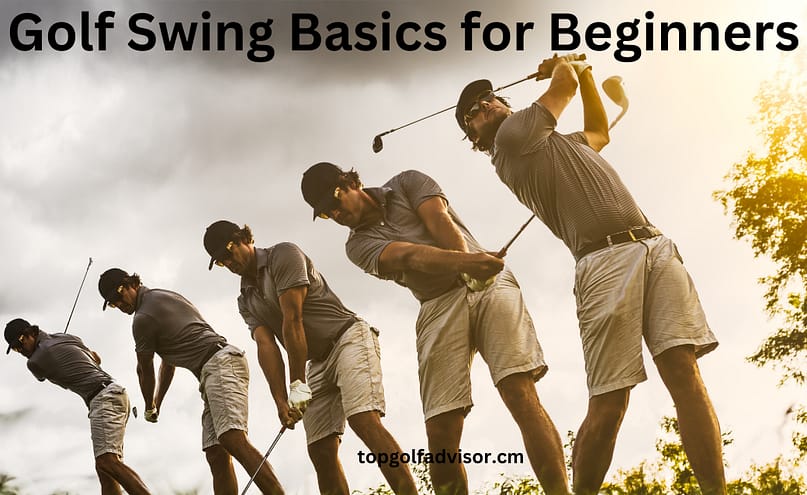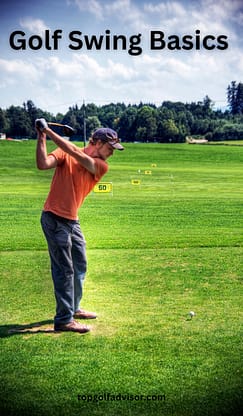Juggling with information from various sites can cause a doozy for a beginner golfer. Therefore, Top Golf Advisor suggests sticking with a source that covers up all the bits and pieces in one go without having to hunt for additional information. We’ll walk through all the golf swing basics for beginners in this blog to clarify the concept in simple steps.
Moreover, you can also read our beginner’s guide to get an overview of What are the basic fundamentals of a golf swing? Everything a novice golfer needs to know before hitting the course.

Golf Swing Basics For Beginners; Setting up the Perfect Swing
It would help if you figured out your grip and stance before you even considered taking a swing. You must ensure that both are correctly configured because you can only swing well with sound technique.
The following steps to help you get on the right track.
Step1: Stance
What body part moves first in golf swing? Mastering the golf stance is pretty straightforward. To begin, position yourself parallel to the starting line with your feet around shoulder width apart. Put your lower body in an athletic position, feeling firm over the golf ball. Your knees should be slightly bent, and the middle of your feet should feel heavy.
According to Wikihow, following the points below can help nail the perfect stance position in golf.
- Start by placing your front foot just in front of the ball.
- Your club will rest close to your body’s centre if you position your feet such that your front foot is slightly in front of the ball.
- With the golf ball in the middle of your stance, your feet should be slightly wider than shoulder-width apart.
- Play your larger clubs, such as hybrids, closer to your front foot and smaller clubs, like irons, closer to the centre of your stance.
- It will be the opposite if you are a right-handed player. Your left foot will be one foot – or less – closer to the hole than the ball.
- If you play lefty, ensure to keep your right foot closer to the hole other than the ball.
Try keeping your hips back and your arms comfortably hanging below you while bending at the waist. Line the end grip of the golf club with your toes, and your arms and chest should form a triangle.
Step 2: Alignment
The direction of your feet and shoulders gets referred to as alignment. Align your feet and shoulders simultaneously along the imaginary line running from your back shoulder to your front shoulder — and from your back foot to your front foot — points directly at your target. You can refer to this alignment as “square.” ” on the course.
For checking alignment, take a stance and place a golf club along the tips of your toes on the teeing area. Take a look at the direction the golf club is pointing. It should be aimed at either your target or the hole itself.
Step 3: Golf Swing Basics For Beginners (Mastering the Grip)

Personal preference governs grip selection, and there are three options available. Furthermore, this section contains a lot of information about hand placement.
For right-handers, the top hand is the left hand, and the bottom is the right.
Left-handed people will use their right hand as their top hand and their left hand as their bottom hand.
Think of this as a roles-reversed situation, and you’re gold for the following games.
Moreover, when it comes to golf swing basics for beginners there are various types of grips every novice should know; let’s jump in and try to cover them all for a better understanding.
- The Baseball Grip
The first grip is the ten-finger grip, also known as the baseball grip.
- As the name implies, this grip entails holding the club with all ten fingers, much like a baseball bat.
- It is usually only recommended for beginners, but the fundamentals apply to any grip.
- Right-handed players will place their left hand on the club’s top, while left-handed players will place their right hand on the club’s top.
- Your other hand will be placed directly beneath it, with the index fingers of your top and bottom hands touching.
- Place your top hand’s thumb on top of the grip, which will be covered by your bottom hand.
- The Overlap Grip
Similar to the baseball grip, the overlap grip, Instead of using all ten fingers on the grip, places the pinky finger of your bottom hand on your top hand.
This way, gripping the club with your top hand, place your bottom handstand’s pinky finger in the crest of your top hand’s index and middle fingers. The rest of the grip will be identical to the baseball grip.
- Interlock Grip
Instead of placing your bottom handstand’s pinky finger on top of your top hand, interlock it with your top handstand’s index finger.
Grip the club with your top handstand’s thumb, pinky, ring, and middle fingers, and point your index finger up. Then, interlace your index finger with your bottom handstand’s pinky.
Always remember to go for the grip that feels the most comfortable playing with, or else you may subject yourself to an hour of torture or, better yet, blocked blood veins that can numb your hands and affect your swing in the long run.
Swinging the Club (Golf Swing Basics For Beginners)
Now that we’ve covered the basics, It’s time to pay attention towards our primary goal; mastering the golf swing. Instead of getting into the theory, we suggest following the steps below for quicker adjustments.
Step 1 the Backswing
The backswing is the movement of raising the club from its starting position and bringing it above your head.
Try to twist your body during the backswing by moving your weight from the front foot’s ball to the back foot’s ball.
Keep an eye out for the three distinct phases of the backswing:
- Phase one: Straighten your arms while keeping them close to your back leg. While doing this, try to keep your front arm straight. The club head bends rearward between your left arm and the club shaft, becoming virtually parallel to the ground.
- Step two: Maintain a slight wrist break while moving your arms parallel to the ground. Your left arm should be roughly perpendicular to the club (for right-handed golfers). The club’s end should point slightly outside the golf ball.
- Part three: Continue rotating your torso back once the clubhead is slightly behind your hands at the apex of the backswing. Towards the end of the backswing, your front arm ought to be slightly bent.
Step 2. The Downside
Swinging down should feel like you’re dragging or slightly pulling the clubhead, causing it to lag behind everything else.
Allow the 90-degree forearm/shaft angle to rise before unwinding quickly through the impact zone. It produces tremendous clubhead speed while allowing the body to move slowly and controllably.
Moreover, when downsizing, remember the following:
- Try to lock your front arm once more so that it is straight, as it was before you started your backswing, just before impact.
- During the downswing, shift your weight from your back foot’s ball to your front foot’s ball. Allow your knees to splay out toward your intended aim. Keep your front knee flexed, especially when hitting a driver, to help your front leg take your weight.
- Always rotate your chest when you swing.
Step3. Make the Shaft Lean Forward for the Target
The club head can strike the ball before passing through the ground because your hands are kept in front of it during impact. Don’t forget to swing your hips to add force to your shot; don’t only rely on your hands to do the heavy lifting.
Step 4. Remembering to follow through
Regardless of how far back you take the club, you should follow through entirely if you release the club correctly.
Your club should be somewhat behind you, your belt buckle should be towards the target, and you should be standing on your lead foot with your rear foot balanced on its toe.
You need to be able to maintain this finish easily while you observe the ball take off into the distance.
Additional Tip: Throughout the backswing and downswing, keep your eyes fixed on the ball.
Lifting your head immediately after hitting the ball to see where it’s going will only cause you to mis-hit the ball. Maintain your gaze on the ball until you’ve completed your follow-through.
Practice With an Expert
Although, as a beginner, you can try your luck out and get your swing right from the start, getting in touch with an expert is always a good idea what you should do and what should you not do in a golf swing?. They can offer you so many insights and correct your posture, alignment, and grip only by looking. It can benefit you in the long run and help you master the swing faster than other beginners on the course.
Moreover, we hope this blog on golf swing basics for beginners proves useful for you all, and prepares you to get into the golfing spirit.
